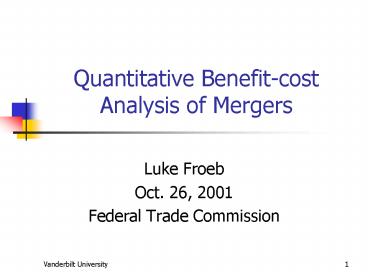Quantitative Benefitcost Analysis of Mergers - PowerPoint PPT Presentation
1 / 15
Title:
Quantitative Benefitcost Analysis of Mergers
Description:
... comparisons, e.g. Staples/Office Depot. Model-based simulations. Vanderbilt University ... e.g., Staples-Office Depot. Good natural experiments or comparisons ... – PowerPoint PPT presentation
Number of Views:41
Avg rating:3.0/5.0
Title: Quantitative Benefitcost Analysis of Mergers
1
Quantitative Benefit-cost Analysis of Mergers
- Luke Froeb
- Oct. 26, 2001
- Federal Trade Commission
2
References
- mba.vanderbilt.edu/luke.froeb/papers/
- Coauthors, Tschantz Werden
- Simulating Merger Effects Among
Capacity-constrained Firms - Pass Through rates and the Price Effects of
Mergers - Merger Effects When Firms Compete by Choosing
Both Price and Advertising - Does retail sector matter for manufacturing
mergers? very preliminary
3
Quantitative benefit-cost analysis
- Goal quantitative estimate of merger effect.
- Necessary to weigh efficiencies against loss of
competition - Two methodologies
- Empirical comparisons, e.g. Staples/Office Depot
- Model-based simulations
4
Empirical Comparisonse.g., Staples-Office Depot
- Good natural experiments or comparisons
- Benefit-cost analysis still requires structural
estimate of pass through - Depends on demand curvature
- big pass-through iff big anticompetitive effect
5
Model-based simulation
- Model current competition
- Estimate model parameters
- Simulate loss of competition from merger
6
e.g. Parking Merger
- Key parameters
- cost of walking
- Sensitivity of choice to price
- location of merging lots
- location of non-merging lots
- capacity of lots
- location of office buildings
7
Simple approach Bertrand Price-setting game
- Static game
- What about dynamic strategies?
- Price-setting competition
- What about product, promotion, placement?
- Unilateral Effects
- What about coordinated effects?
- Does retail sector matter?
- Kroger-Winn Dixie vs. Quaker-Pepsi
8
Simple approach Modeling Critique
- How well does model capture loss of competition
from merger? - Coke strategy is share of throat
- More about placement and product than price
- MCI-Sprint
- Tele-market new plans to rivals customers
- More about promotion than price
- Is Bertrand a good metaphor for loss of
competition?
9
Simple approach Does retail sector matter?
- When is retail sector transparent?
- Constant or constant percentage markup
- two-part tariffs, and retail sector must carry
profitable products - Retail sector earns no profit
- When does it matter?
- Double marginalization?price effect
- Two-part tariffs, and option of exclusivity?no
price effect
10
Simple approach What about advertising?
- FOCs if qq(a,p)
- 0q(p-mc)dq/dp, 0-1(p-mc)dq/da
- FOC if qq(a(p),p)
- 0q(p-mc)dq/dp mcmc(da/dp)/(dq/dp)
- Pre-merger Price-only model with mc
priceadvertising model - Does advertising increase with quantity?
11
Simple approach Implementation
- Estimate AIDS demand
- Scanner data
- Instruments
- None needed for weekly data
- LR vs. SR elasticities (Nevo Hendel)
- Prices in other cities
- Correlated through costs
- Results
- High variance
- Inelastic demand?
- Goods are complements?
12
Implementation Critique too many parameters
- AIDS has too many parameters
- Confidence intervals include both pro- and anti-
scenarios. - Elasticity matrix for merging products is most
important. - Alternatives Logit, nested logit, PD GEV
(Bres.Stern), mixed logit (BLP) census data
(Nevo) - But all goods are substitutes
- Only fool would admit post-merger price rise to
FTC - Agencies discount efficiencies as not
merger-specific - So parties are reluctant to admit even small
price increase. - Proposal assume 5 MC reduction
- Then simulate post-merger prices
13
PD GEVBresnahan Stern
- (multiple) dimensions of differentiation
- Implies substitution patterns
14
Implementation Critique Higher derivatives of
demand
- f(x),f(x), and f(x) influence predicted price
rise. - Need location, velocity, and acceleration
- but observe only location
- If we cannot estimate f(x)
- Product margins
- Hall vs. Hausman in MCI-Sprint
- If we cannot estimate f(x)
- Sensitivity analysis or
- Use linear or logit for extrapolation to be
conservative or - compensating cost differentials dont depend on
acceleration
15
Implementation Critique Average revenue instead
of price
- Average revenue is quantity share-weighted price
index. - Price changes cause weights to change.
- Leads to inelasticity bias
- Use fixed weight index when possible.
- Or use disaggregated data
- store-level data exist
- but we dont use them
- Individual choice data exist
- but we dont use them































